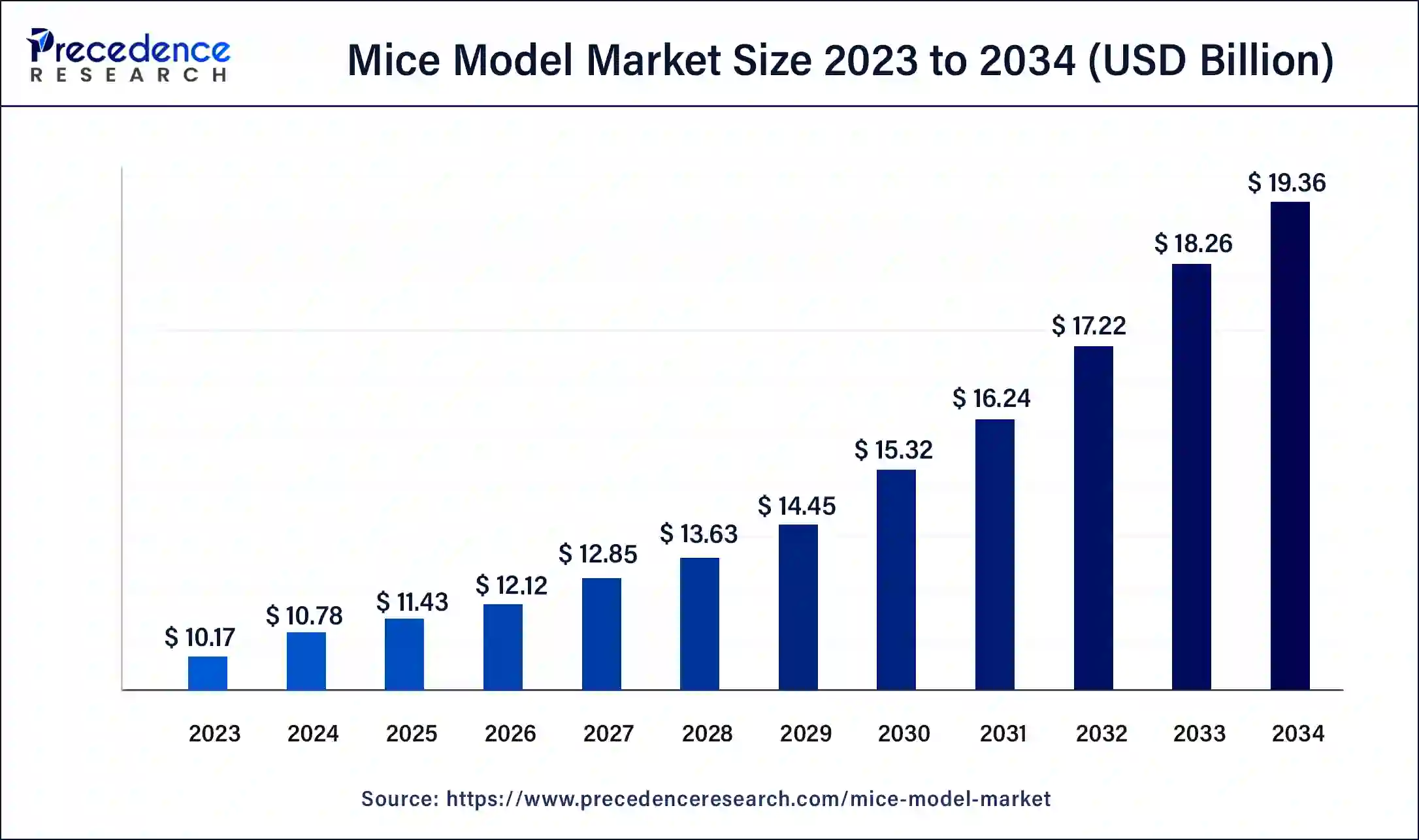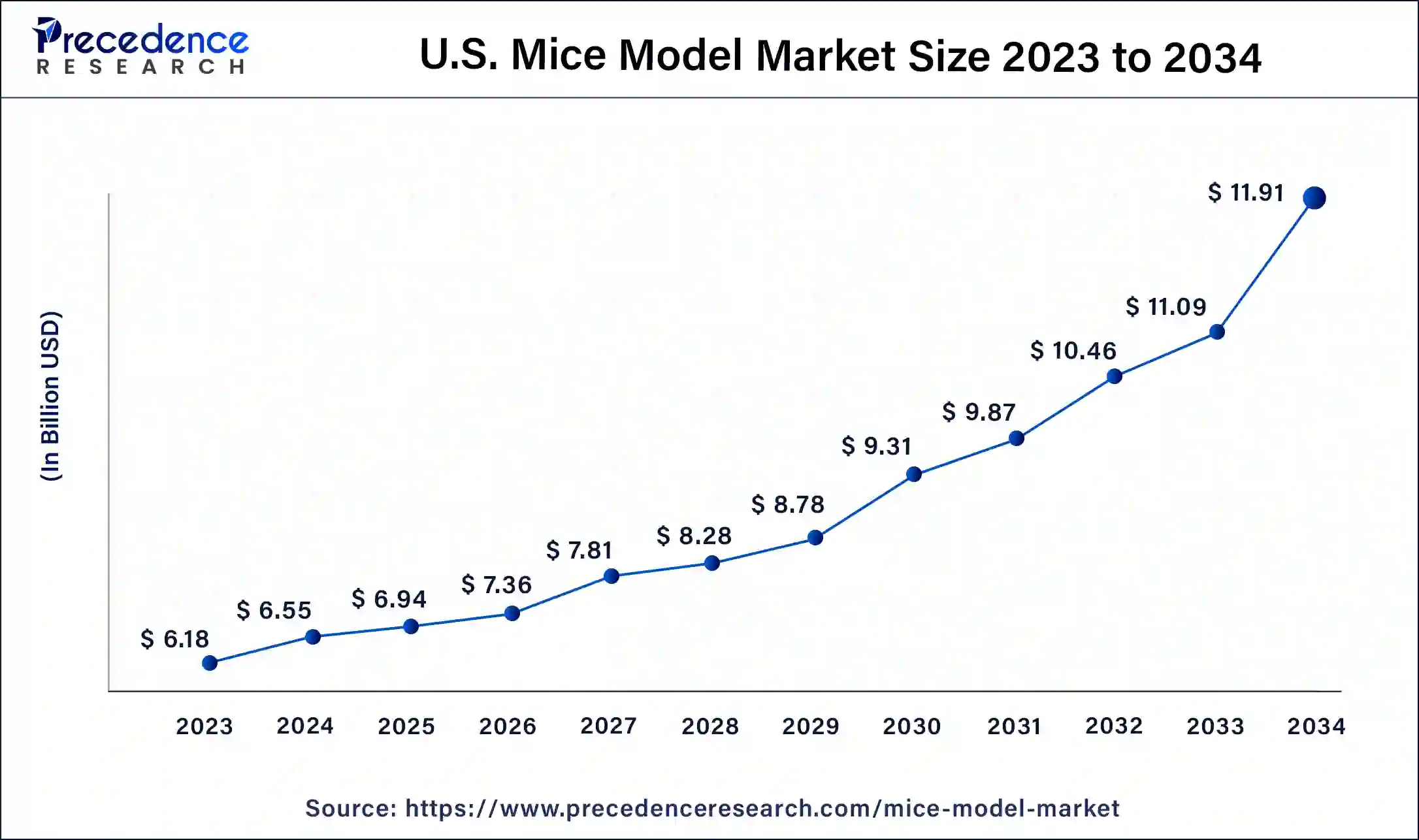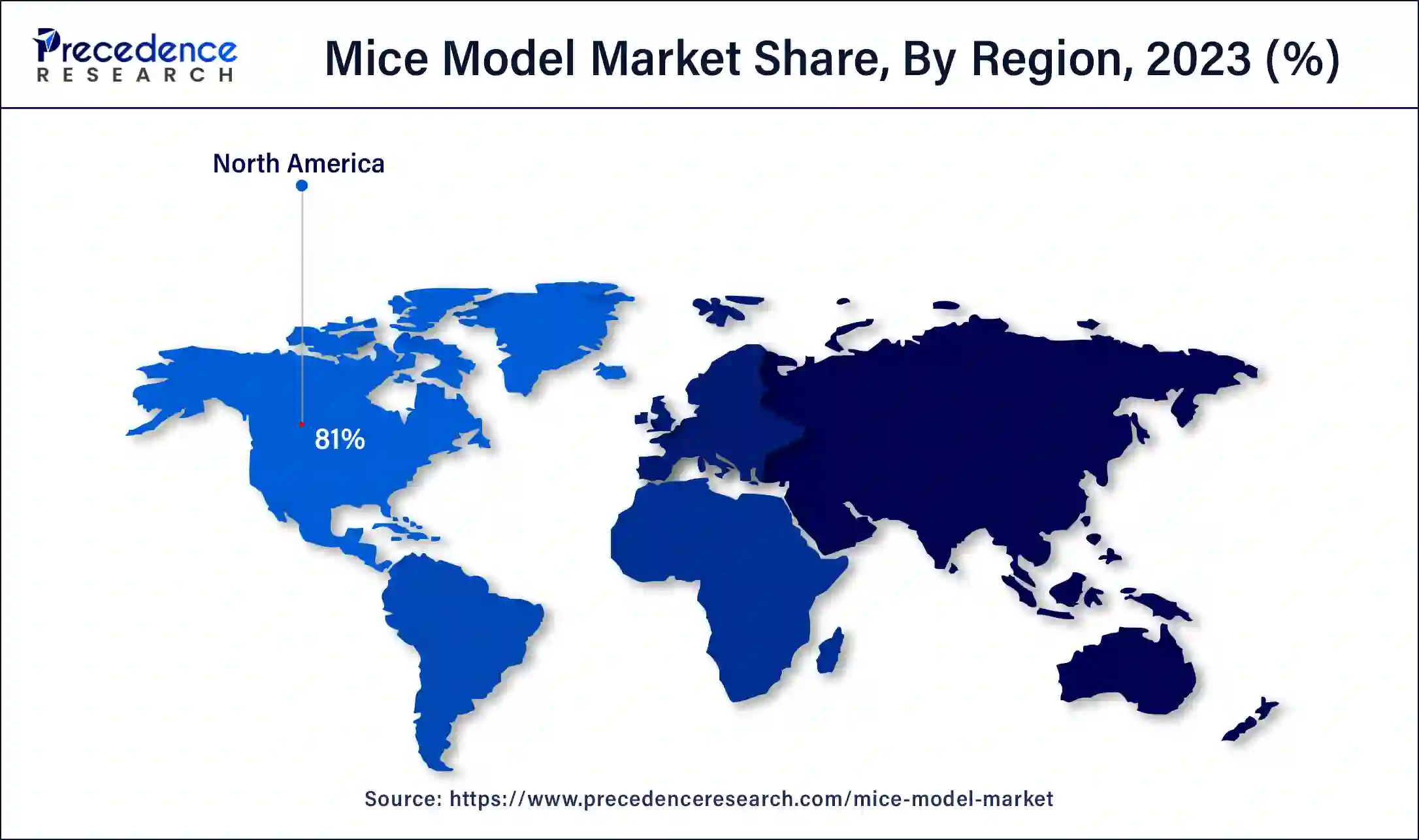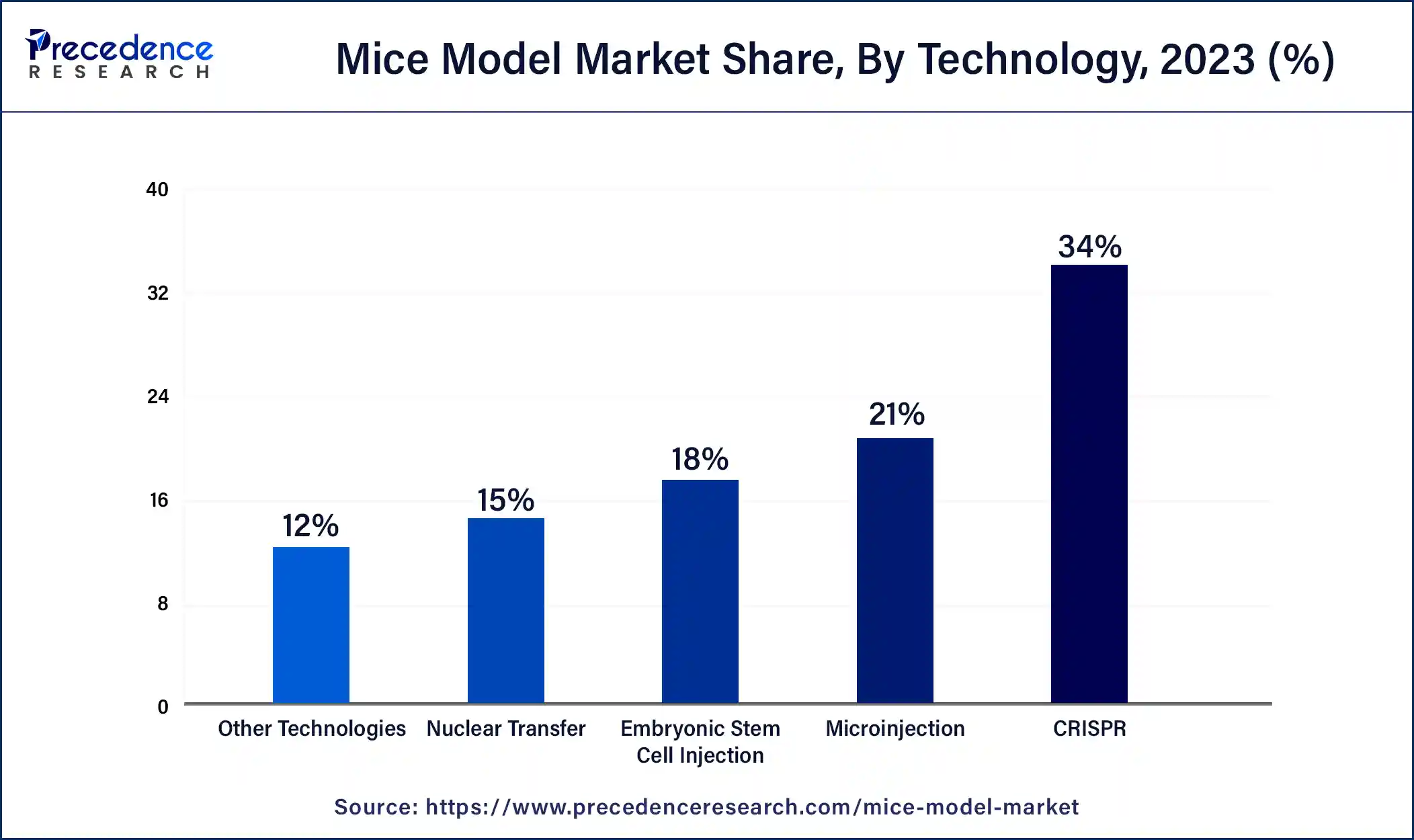February 2024
The global mice model market size surpassed USD 10.17 billion in 2023 and is estimated to increase from USD 10.78 billion in 2024 to approximately USD 19.36 billion by 2034. It is projected to grow at a CAGR of 6.03% from 2024 to 2034.
The global mice model market size is expected to be valued at USD 10.78 billion in 2024 and is anticipated to reach around USD 19.36 billion by 2034, expanding at a solid CAGR of 6.03% over the forecast period 2024 to 2034. The North America mice model market size reached USD 8.24 billion in 2023. The increasing gene editing tools advancements, increased humanized mice model demands, human and mice physiological similarities, increasing personalized medicine consumption in developed and developing countries, etc. contribute to the growth of the market.

The U.S. mice model market size was exhibited at USD 10.17 billion in 2023 and is projected to be worth around USD 19.36 billion by 2034, poised to grow at a CAGR of 6.03% from 2024 to 2034.


Asia Pacific is estimated to be the fastest-growing during the forecast period of 2024-2034. The rapidly expanding biomedical research in the region is driven by rising pharma and biotech industries, rising investment in healthcare infrastructure, and government funding. The increasing prevalence of chronic disorders is raising the demand for mouse models in drug discovery and disease modeling. The growing pharmaceutical sector is fueled by rising demand for innovative therapeutics and healthcare expenditures, which contribute to the growth of the mice model market.
The mice model market is the subgroup of the biotechnology industry that focuses on the use and development of laboratory mice for research purposes. Mice models are the most commonly used animal models for human disease studies and various other good purposes. Mice are biologically the same as humans, and they get various similar diseases for similar genetic reasons. Mice may be genetically influenced to mimic effectively any human condition or disease. The applications of mice models include research and development of different types of diseases, academics, production, quality control, and other applications.
How Can AI Improve the Mice Model?
The use of AI (Artificial Intelligence) in improving mouse models helps the growth of the mouse model market. AI is used in MICE education classrooms to interact with the students with the help of the internet for learning and by using AI to find a certain business. To improve video texture, image domain transformation, and animation and make them resemble real videos, AI is helpful for the MICE education classroom. The use of AI can solve some very old problems in the drug development and discovery process.
| Report Coverage | Details |
| Market Size by 2034 | USD 19.36 Billion |
| Market Size in 2023 | USD 10.17 Billion |
| Market Size in 2024 | USD 10.78 Billion |
| Market Growth Rate from 2024 to 2034 | CAGR of 6.03% |
| Largest Market | North America |
| Base Year | 2023 |
| Forecast Period | 2024 to 2034 |
| Segments Covered | Mice, Technology, and Regions |
| Regions Covered | North America, Europe, Asia-Pacific, Latin America and Middle East & Africa |
Rising gene editing tool advancements
The advancement of targeted gene editing tools has greatly enhanced site-directed mutagenesis and led to better mouse model generation like conditional expression models, gene tagging, knock in and knock out with increased precision and efficiency, and also shorter turnaround, which helps the mice model market growth. Gene editing's most inspiring application is in the field of cell or gene therapy. The benefits of gene editing tools include potential cures for genetic diseases, more accurate and faster diagnosis and treatment of genetic disorders, extending human lifespan, and defeating and tackling diseases.
Downsides of mice models
The downsides of the use of mice models for human diseases include the fact that mice can not be suitable models for specific human diseases, which can hamper the growth of the mice model market. The network linking genes in disease is different in humans and mice. The different mice strains can respond differently to experimental treatments or develop diseases at different rates, which leads to variability in experimental results. Mice lack genetic diversity, which is found in the human population; therefore, results from mice models can not be completely applied to humans.
Collaborative networks expansion
The collaborative network, research, and consortia can facilitate collaborative research, knowledge exchange, and data sharing that are helpful in the mice model community, which helps the growth of the mice model market. Open access initiatives, public & private partnerships, and multi-institutional collaborations will improve scientific discoveries, address global health challenges, and promote pre-competitive research through coordinated efforts in translational medicine and preclinical research.
The inbred segment dominated the mice model market in 2023. The benefits of the inbred mice model include the ability to model specific human diseases, reproducibility, well-defined genetics and characteristics, etc. Inbred mice strains are colonies produced by a minimum of 20 generations of brother-sister mating, resulting in animals that are genetically similar within every strain. In scientific research, these strains are used and contribute to definitive results. As compared to other animal models like rabbits or rats, mice models may be easily genetically operated and inbred mice shows genetic homogeneity.
The outbred segment is expected to be the fastest-growing in the mice model market during the forecast period. Outbred mice are bred specially to maximize genetic diversity and heterozygosity in the population. In an outbred stock theory, no two individuals are genetically identical because of rotational breeding schemes that purposely prevent inbreeding, which contributes to the mice model market. Outbred mice tend to be larger, heartier, and better breeders than inbred mice.
The outbred mice models have many benefits, including increased genetic diversity, which makes them suitable for studying drug exposures and disease genomics, higher reproductive performance, higher disease resistance, longer lifespan, hybrid vigor, etc. Outbred mice models are used for pseudopregnancy, surgical models, aging, efficacy and safety testing, and general multipurpose models, etc.
The CRISPR segment dominated the mice model market in 2023. The CRISPR (Clustered Regularly Interspaced Short Palindromic Repeats) has been used to generate genetically advanced mice models including somatic genome editing models, KI/KO germline models, and mice models for drug treatment. CRISPR is an effective tool for genome editing in mouse models that enables the direct delivery of reagents into mouse zygotes.
CRISPR is RNA-guided genome editing in combination with pronuclear microinjection, which provides simplicity and efficiency for creating genetically engineered mice. As compared to other technologies, the main benefits of Cas-mediated genome engineering/CRISPR are the effectivity of target genomic loci and ease of constructing, designing, and constructing many sgRNAs, suggesting the multiplexed genome editing possibility in mammals.

The microinjection segment is estimated to be the fastest-growing in the mice model market during the forecast period. Microinjection is commonly used in transgenic mice production, which contributes to the growth of the mice model market. It involves introducing of foreign DNA into fertilized eggs to create disease models and to study gene functions.
The pronuclear microinjection method is highly used for generating transgenic mice. Microinjection has many benefits, including injection of small structures with high regeneration potential, enhancement chance for integrative transformation, not limited by the technique, accurate delivery of volume and timing, no need for selection markers, unparalleled accuracy in the delivery of genetic materials, integration and effective transfer of desired genes into host cells genome, etc.
Segments Covered in the Report
By Mice
By Technology
By Geography
For inquiries regarding discounts, bulk purchases, or customization requests, please contact us at sales@precedenceresearch.com
No cookie-cutter, only authentic analysis – take the 1st step to become a Precedence Research client
February 2024
February 2024
July 2024
October 2024